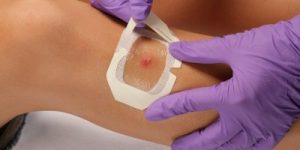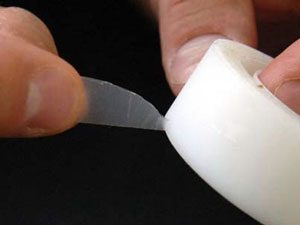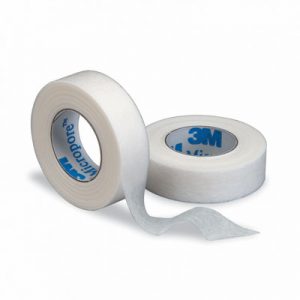Categories
Hypoallergenic Adhesive Tape

There is no question that the development of medical tape has been of enormous benefit in the care of patients. In the days gone by when there was no tape, surgical incisions, lacerations and other wounds were held together with strings and various glue-like substances- all of which were not practical and often led to more problems.
Contents
- Use of Adhesive Tapes in Healthcare
- The Problem with Adhesive Tape
- What is allergic contact dermatitis?
- What are symptoms of adhesive tape allergy?
- So how does one treat allergic contact dermatitis caused by adhesive tape?
- How do you prevent adhesive tape allergy?
- Hypoallergic adhesives
- Do hypoallergenic tapes function well?
- Cost of hypoallergenic tape
- Does tape allergy disappear?
Use of Adhesive Tapes in Healthcare
Fast forward; adhesive tapes have been around for almost a century and are now routinely used on almost every medical floor. In fact, medical adhesive tapes of all types are sold in all pharmacies for home use.
Adhesive tapes have many functions besides just securing gauze and bandages. In a hospital setting, adhesive tapes are used to secure intravenous lines, anchor chest tubes & nasogastric tubes, and help secure a variety of wires and electrodes on the body.

The use of medical adhesive tape is now essential in all types of medical and surgical practice. Over the years, many types of adhesive tapes have been developed and they come in different shapes, sizes, colors, and styles. Today, adhesive tapes are used globally in all healthcare facilities. However, despite the enormous benefits, one major problem has arisen with the use of adhesive tapes- allergy.
The Problem with Adhesive Tape
In the past, it was never conceived that one would develop an allergy to adhesive tapes but now it is known that this problem affects many patients of all ages, cultures, and ethnicity. Initially, it was felt by the healthcare professionals that the rash was not caused by adhesive tape and the problem was ignored for a long time. However, in the last 2 decades, many people have developed allergic reactions to adhesive tape. Now this problem has been recognized as a bona fide complication of adhesive tape. In fact, there have been many studies showing that it is the ingredients/chemicals in the adhesive tape that are the triggers of the allergic response. The exact number of people who have an allergy to adhesive tape is not known but the numbers are not minuscule. It is now emerging to be a daily problem faced by nurses and doctors whenever the tape is applied to the skin. No race or age group is immune from developing an allergy to adhesive tape.

What is allergic contact dermatitis?
Allergic contact dermatitis is essentially a rash that occurs when the skin is irritated. The body’s immune system is usually involved in the reaction. The immune system thinks the body is being attacked by a foreign substance and makes antibodies to fight the invader. A series of biochemical reactions are initiated with the release of potent chemicals of which one of them is histamine. Histamine is what produces the symptoms of allergic contact dermatitis. So when a person has an adhesive tape applied to the skin, the body reacts adversely and causes an intense rash, burning sensation, itching, and redness. Besides adhesive tape, there are hundreds of triggers for this condition.
Most people do not develop reaction the first time the adhesive tape is applied to the skin, but once the body is sensitized the next time the tape is applied it results in a rash.
What are symptoms of adhesive tape allergy?
The classic features of adhesive tape allergy include the following:
- Rash which usually appears 5-30 minutes after application. The rash is usually intensely red and occurs around the edges of the tape.
- Itching: a common feature of adhesive tape allergy is itching. The itching varies from mild to moderate and can be very irritating. The itching usually is one of the first signs of an allergic reaction and it tends to persist even after the tape is removed. When people with itching scratch the area, it can lead to excoriation marks and sometimes even skin breakdown.
- Blisters: in severe cases of adhesive tape allergy, blisters may appear on the skin. While they may appear frightening they are not painful.
- The skin often becomes dry during an allergic reaction.
- Some people with adhesive tape allergy may develop a mild burning sensation. This often continues until the tape is removed.
The rash and itching usually occur within minutes and unless the tape is removed the irritating symptoms will persist. In the majority of people the initial allergic reaction to adhesive tape is mild and may be lasts 15 minutes to a couple of hours; however, with repeated exposure, the reactions tend to be severe and last a lot longer
Once an individual develops contact dermatitis, the skin becomes prone to maceration, breakdown, and infection. The reactions to adhesive tape depend on where it is applied. In general, adhesive tape allergic reaction tends to be more severe in areas of the body where the skin is thin like the face, arms, and neck.
So how does one treat allergic contact dermatitis caused by adhesive tape?
Treating the acute allergic reaction to tape
- If you have an adhesive tape applied and develop a reaction while in a hospital or at home, always inform the nurse or the doctor right away. In all cases, the first treatment is to remove the tape right away.
- Once the adhesive tape is removed, the next step is to wash the area with a mild soap and rinse the site thoroughly with cool running water for 3-10 minutes. You need to gently rub the area so that all residual chemicals from the tape are washed away. In most cases, the majority of symptoms will subside in immediately.
- In some cases, the symptoms may persist and the itching and redness may continue to be bothersome. In this scenario, one should buy an over the counter hydrocortisone cream and apply a thin film over the affected area. Within minutes the symptoms will subside.
- If you have developed blisters from adhesive tape, soak a small piece of cloth in water, cool it in the fridge for 1 hour, and apply it as a cold compress for 20-30 minutes, several times a day. The cold compress will induce a soothing sensation; reduce the redness and itching sensation.
- If you do have any residual itching and dryness, apply an oil-based moisturizer on the skin several times a day. You may have to continue the moisturizer for several days.
How do you prevent adhesive tape allergy?
- Anyone who has developed allergic reaction to tape should ensure that they never use that tape again
- For people who visit healthcare facilities regularly, one should always tell the healthcare professional if you have any allergies. Sometimes if you have an allergy to one substance, you may also develop allergies to other foreign substances.
- In fact, if you are prone to allergies, you should wear a bracelet stating your allergies so that healthcare professionals know about it in case of an emergency
Hypoallergic adhesives
In the last decade, there have been a number of hypoallergenic tapes developed. These tapes are now available in healthcare institutions, emergency rooms, urgent care centers, doctor’s clinics and even in pharmacies. One can easily purchase these medical supplies from any medical supplier or pharmacy. These products are less likely to cause an allergic reaction compared to the traditional adhesive tapes. However, for individuals who are very susceptible to allergies, it is important to first perform a skin patch test. Cut out a small piece of the hypoallergenic tape and place it on your forearm. If you do not develop a reaction in 30-60 minutes, then this hypoallergenic tape is ideal for you. There are many types of hypoallergenic tapes on the market and by far and large, they all work well for people with allergies.
Do hypoallergenic tapes function well?
Hypoallergenic tapes provide the same function as the conventional adhesive tapes but contain far fewer synthetic chemicals- so that the risk of an allergic reaction is very low. These tapes have the following benefits:
- Provide gentle adhesion to skin
- Less likely to traumatize skin
- They are comfortable and easy to use
- The tapes are not occlusive and thus allow the wound or incision to be adequately aerated.
- They can secure dressing, chest tubes, electrodes and intravenous lines just as well as any regular adhesive tape.
- The tapes are relatively inexpensive
Cost of hypoallergenic tape
If you or someone in your household is prone to cuts and injuries and has allergies to tape, hypoallergenic tapes are inexpensive and can be bought in most retail pharmacies. In fact, many medical suppliers even sell these products online. Always buy a small amount first to determine if the product is truly hypoallergenic; and if it works, stick to one brand. If you have no idea which brand to buy, speak to a medical supplier representative or your healthcare provider.

Does tape allergy disappear?
Unfortunately once adhesive tape allergy has developed, it never disappears. The allergy is life long and anytime in future if you use adhesive tape, the reaction will re-occur. Even though some healthcare practitioners do promote desensitization, this procedure is prohibitively expensive, frequently does not work, and is time-consuming.



